


|

|
|
|
|
Introduction
This topic includes the following sections:
This topic describes the interoperability and coexistence capabilities in the WebLogic Enterprise (WLE) T-Engine among the CORBA, J2EE, and Tuxedo programming models.
This topic describes the T-Engine interoperability sample applications provided with the WebLogic Enterprise software. The sample applications provide client and server programmers with information about the basic concepts of combining Enterprise JavaBeans (EJBs) and CORBA objects in the same WebLogic Enterprise application.
Note: These examples specifically refer to interoperability within the T-Engine environment.
Note: In WebLogic Enterprise 5.1, interoperability between the J-Engine and T-Engine is available in only one direction-from the J-Engine to the T-Engine. The product does not support calling the J-Engine from the T-Engine.
Interoperability Among the CORBA, J2EE, and Tuxedo Programming Models
The key interoperability features are presented in the following categories:
First, a summary description of BEA clients, servers, the T-Engine, and the J-Engine follows.
BEA Clients and Servers
Note the following definitions:
A BEA client can be any of the following entities, which exist outside the BEA domain and must use a listener/handler as a gateway to the domain:
Note that BEA clients invoking other BEA clients is not supported.
A BEA server can fall into one of two general categories:
T-Engine Server Interoperability
This section describes the interoperability among the following T-Engine server components:
Figure 1-1 shows the direct interoperability support among the various T-Engine server applications. The numbered callouts in the figure are explained in the text that follows the figure. In this figure, the solid black arrows show the direct invocation paths that are supported. The dotted arrows show indirect invocation paths that are supported; for example, a Tuxedo service can invoke a CORBA Java object using either a CORBA C++ proxy object, or a C++ client stub file compiled from the OMG IDL for that Java object.
Figure 1-1 T-Engine Server Interoperability
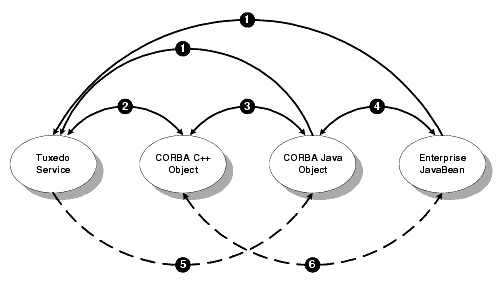
Note the following details about the preceding figure:
WebLogic Enterprise provides the Java Enterprise Tuxedo (JET) API that you can use to have either a CORBA Java object or a T-Engine EJB invoke a Tuxedo service running in the WebLogic Enterprise domain. An example of a CORBA Java object invoking a Tuxedo service using JET is described in CORBA/Java-to-Tuxedo Simpapp Sample Application, and an example of an EJB application invoking a Tuxedo service using JET is described in EJB-to-Tuxedo Simpapp Sample Application. (Note that RMI server applications can also run in the WebLogic Enterprise T-Engine domain, and they can also use JET to invoke Tuxedo services in that domain.)
For considerations about using the JET software, see Java Enterprise Tuxedo (JET) Software.
A C++ object can include ATMI calls to Tuxedo services. See the Wrapper University sample application, available from the Guide to the University Sample Applications, for an example application that shows this feature.
A Tuxedo service can invoke a CORBA C++ object using the compiled C++ client stub file for that object. (One way to do this is to implement the Tuxedo service as a C-callable C++ function that invokes the client stub file for the C++ object. If you use this approach, note that you need to link in the C++ ORB libraries when you build the Tuxedo service.)
CORBA C++ and CORBA Java objects that run in the same WebLogic Enterprise domain can invoke each other directly. For information about invoking across WebLogic Enterprise domains, see the section T-Engine Interdomain Interoperability.
In the WebLogic Enterprise environment, a CORBA Java object can invoke methods on a T-Engine EJB directly. See CORBA/C++-to-T-Engine EJB Simpapp Sample Application, for an example application that includes a CORBA Java object that invokes an EJB.
A Tuxedo service can invoke a CORBA Java object by compiling the Java object's OMG IDL file with the idl command, which produces a C++ client stub file that the Tuxedo service can invoke, using an approach similar to the one described in point 2.
T-Engine EJB-to-CORBA/Java Simpapp Sample Application, shows an example of an EJB invoking a CORBA Java object. You can extend this example to include a CORBA C++ object by designing the Java object in that application to serve as an intermediary, or wrapper, object that delegates invocations from the EJB to the C++ object, and vice versa. An alternative means for having an EJB invoke a C++ object is to compile the OMG IDL file for the C++ object using the m3idltojava command, which produces a Java client stub file that the EJB can invoke directly.
Java Enterprise Tuxedo (JET) Software
The WebLogic Enterprise software includes the JET API, which allows T-Engine Java entities -- namely, EJBs and CORBA Java objects -- to make ATMI calls on Tuxedo services that exist in either the same WebLogic Enterprise domain or in a separate WebLogic Enterprise domain. JET is a server-side adaptation of BEA Jolt. JET shares some of its software components with Jolt, including the Repository Editor and the bulk loader. To take full advantage of all the capabilities of JET, you need to install the Jolt software, which is included with the WebLogic Enterprise software.
For more information about JET, see Using Java Enterprise Tuxedo (JET). For more information about installing Jolt, see the Jolt Installation Guide, which is included in the WebLogic Enterprise package.
Note: JET cannot be used by Java clients to invoke Tuxedo services; this capability is provided by BEA Jolt, which is summarized in Transactions and Security Within the T-Engine Environment.
Transactions and Security
Transaction and security context propagation among BEA server applications running in a WebLogic Enterprise domain is fully supported.
T-Engine Client and Server Interoperability
Figure 1-2 shows the interoperability support among BEA clients invoking BEA servers.
Figure 1-2 T-Engine Client and Server Interoperability
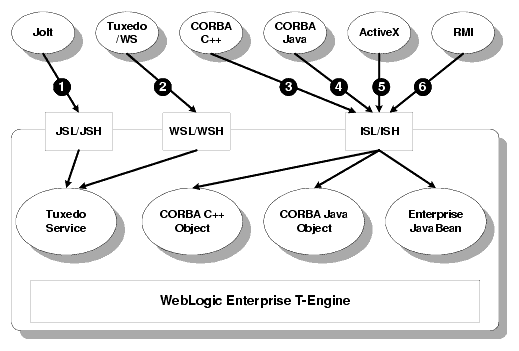
Note the following details in the preceding figure:
A Jolt client can invoke a Tuxedo service running in the WebLogic Enterprise domain via a Jolt listener/handler. For more information about Jolt, see the BEA Jolt online documentation.
A Tuxedo /WS client application can invoke a Tuxedo service running in the WebLogic Enterprise domain via the Workstation listener/handler.
A BEA CORBA C++ client application can invoke both CORBA C++ and Java objects running in a WebLogic Enterprise domain via the IIOP listener/handler. For more information, see Creating CORBA Client Applications.
A BEA CORBA Java client application can invoke both CORBA C++ and Java objects running in a WebLogic Enterprise domain via the IIOP listener/handler. For more information, see Creating CORBA Client Applications.
A BEA ActiveX client application can invoke both CORBA C++ and Java objects running in a WebLogic Enterprise domain via the IIOP listener/handler. For more information, see Creating CORBA Client Applications.
An RMI client application can invoke an Enterprise JavaBean running in the WebLogic Enterprise domain via the IIOP listener/handler using the WebLogic RMI-on-IIOP protocol. For more information, see Using RMI in a WebLogic Enterprise Environment. (Note that an RMI client can also invoke an RMI server running in a WebLogic Enterprise domain.)
The following additional invocation paths are also supported in the WebLogic Enterprise T-Engine environment via proxy objects or servers:
You can create a C++ client with a set of operations that map one-to-one with calls to Tuxedo services using an intermediary C++ server-side object. See the Wrapper University sample application for an example application that shows this feature, available in the Guide to the University Sample Applications.
A WebLogic Enterprise T-Engine RMI client application can invoke a CORBA C++ object by using a T-Engine EJB and a CORBA Java object in the server process as intermediaries. For an example, you can extend the sample application described in T-Engine EJB-to-CORBA/Java Simpapp Sample Application, as follows:
A WebLogic Enterprise T-Engine RMI client application can invoke a CORBA Java object by using a T-Engine EJB as an intermediary. For an example, you can extend the sample application described in T-Engine EJB-to-CORBA/Java Simpapp Sample Application, to have the RMI client application initiate the request instead of the EJB.
Interoperability is provided via a Tuxedo service wrapper. You create a Tuxedo service wrapper as a CORBA C++ object that runs in the WebLogic Enterprise domain and that makes invocations on the legacy CORBA C++ object.
Interoperability is provided via a Tuxedo service wrapper.
Interoperability is provided via a Tuxedo service wrapper on a CORBA Java object in the server process, which then delegates the invocation to the EJB.
Transactions and Security Within the T-Engine Environment
Transaction and security context propagation between T-Engine client and server applications is fully supported, with the following restrictions:
For example, a client can begin a transaction and make multiple invocations on services and objects within the domain, and those services and objects can in turn make invocations on yet other services and objects. However, the client application cannot, within the scope of that transaction, perform operations locally and have them included in that transaction. That is, if the client application starts a transaction, invokes an object within the domain, then writes data to a database local to the client, the local database operation cannot not be included in the transaction.
BEA Jolt provides a means for allowing Java clients to make ATMI calls on Tuxedo services that exists in a Tuxedo or WebLogic Enterprise domain. Jolt also provides a means for allowing J-Engine servers to invoke T-Engine Tuxedo services . This latter capability is performed via Jolt connection pools, which is shown in J-Engine and T-Engine Interoperability. BEA provides Jolt with the WebLogic Enterprise software.
For more information, see the following documents:
T-Engine RMI Clients and the WebLogic RMI-on-IIOP Protocol
RMI clients of EJBs running in a T-Engine domain must use the WebLogic RMI-on-IIOP protocol. This is a proprietary protocol and is different from the RMI-over-IIOP protocol, which is used by clients of the BEA WebLogic ServerTM system.
For more information about the WebLogic RMI-on-IIOP protocol, see Using RMI in a WebLogic Enterprise Environment.
J-Engine and T-Engine Interoperability
The WebLogic Enterprise domain can comprise both T-Engine and J-Engine components. As of WebLogic Enterprise 5.1, this connectivity is available in only one direction-from the J-Engine to the T-Engine.
Figure 1-3 shows how IIOP and Jolt connection pools allow components hosted by the J-Engine can invoke objects and services hosted by a T-Engine running in the same WebLogic Enterprise domain.
Figure 1-3 J-Engine and T-Engine Interoperability
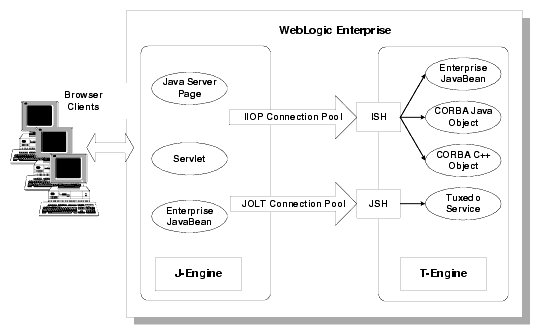
Note the following about these connection pools:
For details about the versions of J-Engine and T-Engine server components that can interoperate, see the Release Notes.
Third-party ORB Interoperability
CORBA applications based on third-party ORBs can interoperate with CORBA, Tuxedo, and J2EE server applications running in a WebLogic Enterprise T-Engine domain provided that there is a correct match-up between IIOP protocols. Figure 1-4 provides a high-level view of third-party ORB interoperability with WebLogic Enterprise.
Figure 1-4 Third-party ORB Interoperability
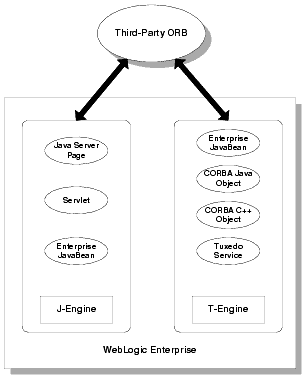
Note the following regarding third-party ORB interoperability with WebLogic Enterprise:
T-Engine Interdomain Interoperability
A server application running in one WebLogic Enterprise domain can interoperate with a server application running in another WebLogic Enterprise domain via the domain gateway (and not IIOP), as shown in Figure 1-5.
Figure 1-5 T-Engine Interdomain Interoperability
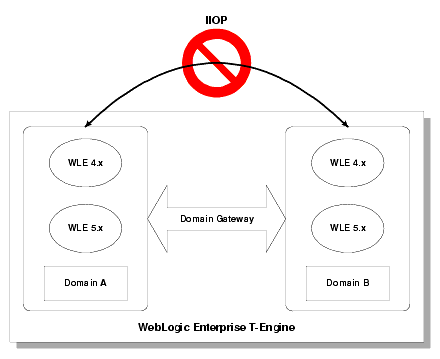
Domain gateways provide the following interoperability features:
When a client application authenticates itself to the domain, and invokes various services and objects in the domain -- which in turn may invoke other services and objects in the domain -- the client's security context is passed along with each operation. However, if in the course of satisfying a client request, a service in one domain makes an invocation on a service in a second domain, the client's security context cannot be passed to the second domain. The service in the second domain does not have knowledge of the original client.
For more information about interdomain WebLogic Enterprise interoperability, see Administration in the WebLogic Enterprise online documentation.
WebLogic Enterprise and Tuxedo Domains Interoperability
WebLogic Enterprise and Tuxedo domains can interoperate via domain gateways, as shown in Figure 1-6.
Figure 1-6 WebLogic Enterprise and Tuxedo Domains Interoperability
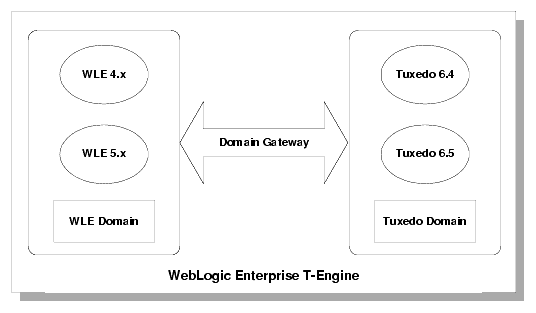
Note the following about WebLogic Enterprise and Tuxedo interdomain interoperability:
For more information about WebLogic Enterprise and Tuxedo domains interoperability, see Administration in the WebLogic Enterprise online documentation.
Overview of the T-Engine Interoperability Sample Applications
The WebLogic Enterprise software includes the sample applications as described in Table 1-1.
Table 1-1 The Interoperability Sample Applications
|
Application |
Description |
|---|---|
|
T-Engine EJB-to-CORBA/Java Simpapp |
Shows an EJB server acting as a client invoking a request and receiving a response from a CORBA/Java object. |
|
CORBA/C++-to-T-Engine EJB Simpapp |
Shows CORBA/C++ client invoking a request and receiving a response from an EJB server. |
|
CORBA/Java-to-Tuxedo |
Shows a CORBA/Java object that invokes a Tuxedo service using the Java Enterprise Tuxedo (JET) API. |
|
T-Engine EJB-to-Tuxedo |
Shows an Enterprise JavaBean application that invokes a Tuxedo service using the Java Enterprise Tuxedo (JET) API. |
Use the interoperability sample applications in conjunction with the following documents:

|

|
|
|
|
Copyright © 2000 BEA Systems, Inc. All rights reserved.
|